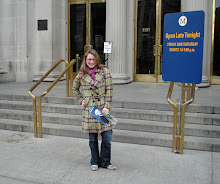Okay, these first two pictures are not Modern Art, but I'll get to it, I promise.


I arrived at the Met a little bit early for my 3:00 Modern Art tour, so I found myself gravitating toward the Egyptian Wing — in fact, I made a beeline for the Sackler Wing and the Temple of Dendur. There I sat across from the windows, looking out at the clouds hovering over the autumn colored trees in Central Park. So relaxing.
On to the day's business:
Modern Art.

We began with a portrait of Gertrude Stein by Pablo Picasso, painted when the artist was only twenty-four. The significance of this painting is its obvious shift from realism to abstract in the subject's face. Instead of representing Stein's face as at appeared visually (of which he was perfectly capable), Picasso struggled to express her intelligent, contemplative, character through her facial features. The change in intention, from simply representing things as they look to expressing a feeling or idea, marks the beginning of the Modern Art movement.

Next, we turned directly the left to examine a painting by Henri Matisse. His use of bright, flat colors and lack of detail were revolutionary at the time, but the most interesting thing about this piece is that it is actually a painting within a painting. The subject is Matisse's studio, and the dancers are actually part of a mural that was leaning against the wall while he painted this. Notice the back leg of the stool lands inside the green field of the mural. Matisse cleverly eliminated reality with this detail.
Jackson Pollock is probably the most popularly misunderstood artist (in my experience alone, I've heard heavy criticism). Some people just glance at his work and proclaim that anyone could do that, that it's ugly, that it couldn't possibly represent anything.

But, for me, especially after this tour, Pollock's work represents everything that goes on inside the mind. Not everyone could do that and make it look the way Pollock did — otherwise the copycats would be just as famous. While I sat looking at the canvas, the paint began to vibrate, to come toward me, to move around, interacting with itself. It's one of those "had to be there moments," it was magical.

Next up: Rothko. I know by now that a highly recognized modern artist is significant for a reason, but I hadn't taken the time to find out why Rothko made the ranks. His work isn't inherently interesting or even visually pleasing, but just one explanation by our tour guide had me convinced that he earned his status. Rothko's work represents universal human emotions — he was influenced by Carl Jung, and (at least in this particular painting) his subject was man's futile and tragic quest for immortality (according to our guide). When you look at the blocks of color, the red jumps forward at you, while the white fades to the back; the yellows at the top and bottom and even the the darker left and right edges contain the color within the painting. The fact that the artist intentionally laid the color on the canvas in such a way so as to express his feelings and ideas is itself the importance of the work.

Ellsworth Kelly depicted reality, purged of detail, form and dimension. From his bird watching hobby as a youth, Kelly became interested in the way we perceive things as fragments (referring to the frame of binoculars) and as flat color (which, apparently can be done with a certain bird watching tool). He said "my paintings are fragments of the visual world without the third dimension."

This piece by Donald Judd explores the idea of self-referential minimalism. The identical boxes are the subject, referring to their subtle differences as visual contrasts. I particularly enjoyed the interplay of shadows below.

I'll end with this work by Joel Shapiro. Its construction teeters at the edge of impossibility, as it appears off-balance. The sculpture is made of aluminum painted red, but when you look up close, it has the texture of wood. It's amazing, really, it actually shows no indication that it is not made of wood. Shapiro intended to create this contradiction to represent his fear that the organic would become robotic — that man, obsessed with machinery, would one day be replaced by his invention.
As a child of the late 20th century, it is hard for me to grasp the fact that the idea of abstract expression was INVENTED in the last century. With a graphic design background, I have grown to greatly appreciate Modern Art for the mysterious feelings and ideas hidden in the canvases, sculptures and sometimes
sharks in formaldehyde solution (The Physical Impossibility of Death in the Mind of Someone Living by Damien Hirst is intriguing to me, I'm sure I'll visit that in a post soon). In conclusion, though it is sometimes incredibly simple, sometimes ridiculous, sometimes ugly, Modern Art is what it is because nobody thought to do it before, it carries so much meaning and intent that it is difficult not to appreciate it.
MAP:








































